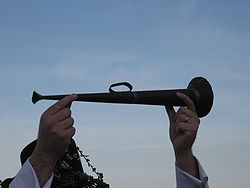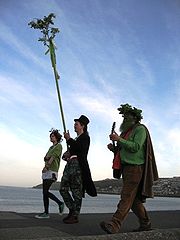
West Cornwall May Day Celebrations
Encyclopedia

Cornwall
Cornwall is a unitary authority and ceremonial county of England, within the United Kingdom. It is bordered to the north and west by the Celtic Sea, to the south by the English Channel, and to the east by the county of Devon, over the River Tamar. Cornwall has a population of , and covers an area of...
, United Kingdom
United Kingdom
The United Kingdom of Great Britain and Northern IrelandIn the United Kingdom and Dependencies, other languages have been officially recognised as legitimate autochthonous languages under the European Charter for Regional or Minority Languages...
, associated with the coming of spring. The celebration of May Day is a common motif throughout Europe and beyond. In Cornwall there are a number of notable examples of this practice including the Obby Oss in Padstow
Padstow
Padstow is a town, civil parish and fishing port on the north coast of Cornwall, England, United Kingdom. The town is situated on the west bank of the River Camel estuary approximately five miles northwest of Wadebridge, ten miles northwest of Bodmin and ten miles northeast of Newquay...
and Furry Dance
Furry Dance
The Furry Dance, also known as The Flora , takes place in Helston, Cornwall, and is one of the oldest British customs still practised today...
or Flora day in Helston
Helston
Helston is a town and civil parish in Cornwall, England, United Kingdom. It is situated at the northern end of the Lizard Peninsula approximately 12 miles east of Penzance and nine miles southwest of Falmouth. Helston is the most southerly town in the UK and is around further south than...
. The celebrations are in contrast to the Cornish
Cornish people
The Cornish are a people associated with Cornwall, a county and Duchy in the south-west of the United Kingdom that is seen in some respects as distinct from England, having more in common with the other Celtic parts of the United Kingdom such as Wales, as well as with other Celtic nations in Europe...
midwinter celebration
Winter solstice
Winter solstice may refer to:* Winter solstice, astronomical event* Winter Solstice , former band* Winter Solstice: North , seasonal songs* Winter Solstice , 2005 American film...
s that occur every year such as the Penzance
Penzance
Penzance is a town, civil parish, and port in Cornwall, England, in the United Kingdom. It is the most westerly major town in Cornwall and is approximately 75 miles west of Plymouth and 300 miles west-southwest of London...
Montol Festival
Montol Festival
The Montol Festival is an annual heritage, arts and community festival in Penzance, Cornwall held between the 16th and 22nd of December each year. The festival is a revival or reinterpretation of many of the traditional Cornish midwinter customs & Christmas traditions formerly practiced in and...
and the Padstow
Padstow
Padstow is a town, civil parish and fishing port on the north coast of Cornwall, England, United Kingdom. The town is situated on the west bank of the River Camel estuary approximately five miles northwest of Wadebridge, ten miles northwest of Bodmin and ten miles northeast of Newquay...
Mummer's Day
Mummer's Day
Mummer's Day, or "Darkie Day" as it is sometimes known, is an ancient Cornish midwinter celebration that occurs every year on Boxing Day and New Year's Day in Padstow, Cornwall...
festival.
Practice before the 20th century
Prior to the 20th century it was common for young residents of the towns of PenzancePenzance
Penzance is a town, civil parish, and port in Cornwall, England, in the United Kingdom. It is the most westerly major town in Cornwall and is approximately 75 miles west of Plymouth and 300 miles west-southwest of London...
and St Ives
St Ives, Cornwall
St Ives is a seaside town, civil parish and port in Cornwall, England, United Kingdom. The town lies north of Penzance and west of Camborne on the coast of the Celtic Sea. In former times it was commercially dependent on fishing. The decline in fishing, however, caused a shift in commercial...
and other nearby settlements to conduct their own festivities. During this festival it was usual to make 'May Horns' usually fashioned from tin cans and 'May Whistles' made from small branches of the sycamore
Sycamore Maple
Acer pseudoplatanus, the sycamore maple, is a species of maple native to central Europe and southwestern Asia, from France east to Ukraine, and south in mountains to northern Spain, northern Turkey, and the Caucasus. It is not related to other trees called sycamore or plane tree in the Platanus...
tree. The tree branches also formed decorations for people's homes.
The following is from a contemporary description of the events themselves in 1881 collected by Robert Hunt in 'Popular Romances of the West of England Online Transcript of the original

THE first of May is inaugurated with much uproar. As soon as the clock has told of midnight, a loud blast on tin trumpets proclaims the advent of May. This is long continued. At daybreak, with their "tintarrems," they proceed to the country, and strip the sycamore-trees (called May-trees) of all their young branches, to make whistles. With these shrill musical instruments they return home. Young men and women devote May-day to junketing and picnics.
It was a custom at Penzance, and probably at many other Cornish towns, when the author was a boy, for a number of young people to sit up until twelve o'clock, and then to march round the town with violins and fifes, and summon their friends to the Maying.
When all were gathered, they went into the country, and were welcomed at the farmhouses at which they called, with some refreshment in the shape of rum and milk, junketJunketJunket can refer to:*an excursion for the purpose of pleasure at public or company expense *Junket , a dessert made of flavoured, sweetened curds*Junket , a brand name of rennet tablets and dessert mixes...
, or something of that sort.
They then gathered the "May," which included the young branches of any tree in blossom or fresh leaf. The branches of the sycamore were especially cut for the purpose of making the "May-music." This was done by cutting a circle through the bark to the wood a few inches from the end of the branch. The, bark was wetted and carefully beaten until it was loosened and could be slid off from the wood. The wood was cut angularly at the end, so as to form a mouth-piece, and a slit was made in both the bark and the wood, so that when the bark was replaced a whistle was formed. Prepared with a sufficient number of May whistles, all the party returned to the town, the band playing, whistles blowing, and the young people singing some appropriate song.

